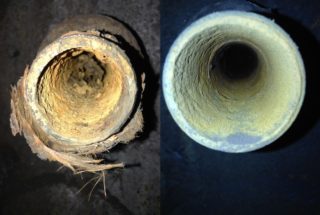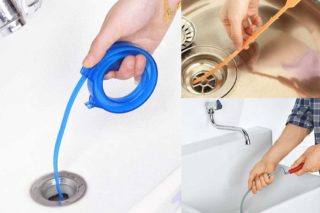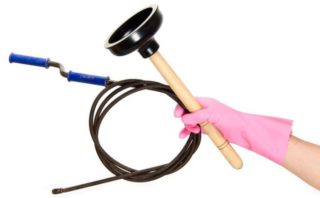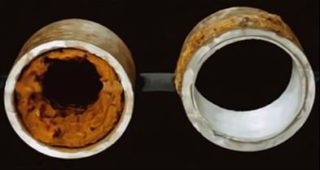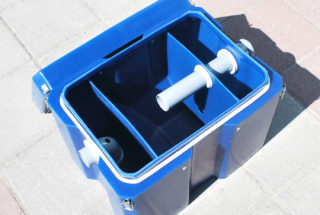An unpleasant smell from the drain hole, a decrease in the rate of drainage of water or its complete stagnation are the most obvious signs of a clogged sewer. A blockage can occur both due to the accumulation of fat, food debris, hair and other contaminants on the pipe walls, and due to incorrect installation and the absence of a standard slope to the riser. Also, metal salts present in water can provoke clogging. Regardless of the reasons, you can and should try to cope with the problem on your own, without waiting for the moment when you need to call a team of plumbers.
What is the essence of the mixed cleaning method
Here is a simple example of a mixed sewer cleaning method:
- Pour a few liters of boiling water into the pipe.
- Wait 10-15 minutes.
- Remove the blockage with a plunger.
- Pour 1/2 pack of baking soda into the drain and pour boiling water or 9% vinegar in a 1: 3 ratio.
- When choosing the option with vinegar, make sure to plug the hole with a rag while waiting, because the vinegar that has entered into a chemical reaction with soda can give a copious release of foam.
- After 5-10 minutes, rinse the drain with plenty of water.
Option using baking soda in combination with salt:
- 1/2 cup salt is mixed with 1 cup baking soda and 1 cup water.
- The resulting mixture is poured into the drain hole and left there for 10-15 minutes.
- Without flushing, the drain is cleaned with a plunger.
- In case of incomplete cleaning of the blockage, the procedure is repeated.
By analogy with the methods described, a plunger or rope can be used in combination with a chemical agent.
- A cleaning agent is poured or poured into the intended place of blockage and kept for the required amount of time, in accordance with the instructions.
- The pipe is thoroughly rinsed with hot water.
- In case of incomplete cleaning, use a cable or plunger.
Thus, a double effect is achieved: thanks to the cleaning agent, the blockage is completely or partially dissolved, and the plunger or cable can easily remove the debris that caused the problem. For the best effect, pay attention to the composition of the selected cleaning agent. To remove the accumulation of fat in pipes in the kitchen, alkaline preparations are used, but for the bathroom it is better to choose a product with an acid base, because it is specifically designed to dissolve organic waste, such as hair and end products of life of the residents of the house.
Please note that plastic pipes, as opposed to cast iron and metal, need a special approach. To clean them, it is not recommended to use boiling water and a steel cable, in order to avoid rapid wear of rubber gaskets and mechanical damage to the pipe walls.
Pros and cons of the method in comparison with the rest
- the possibility of cleaning, without the use of chemicals with toxic fumes;
- high efficiency, in comparison with the use of only a chemical or only mechanical cleaning method;
- the ability to eliminate even a difficult-to-dissolve blockage on your own, without resorting to the help of a plumbing service;
- availability and cheapness, because there is a plunger or cable in every home, just like vinegar and soda can be found in the kitchen of any housewife;
- Chemicals are dangerous not only by inhalation of toxic vapors and chemical burns in case of contact with the skin, but also by the possibility of destroying the integrity of old cast-iron pipes. If you choose mixed cleaning using folk remedies, all these threats can be avoided.
This method has only one drawback: if the blockage is large enough and old, or if it is localized in a common riser, it will most likely not be possible to eliminate the problem without the help of a plumber with specialized equipment. However, even powerful store tools will not help in such a situation.
When to use the mixed method
- such cleaning can be used for preventive purposes, because it does not take much time, and it is not affordable. By regularly cleaning the pipes even before blockages form, you are guaranteed to protect the water supply from unforeseen blockages;
- the option with a plunger is perfect in case of clogging of plastic pipes and the impossibility of using aggressive chemicals;
- the use of cleaning agents in combination with a steel cable will save in case of difficult-to-dissolve blockage of metal or cast-iron pipes;
- when a blockage accumulates in the pipes, provoked by the ingress of foreign objects, it will be convenient to partially dissolve the blockage with a chemical agent or a combination of soda and vinegar, and remove the residues with a plunger or cable.
Preventing future blockages
A sewer blockage, like any other problem, is always easier to prevent than to eliminate the consequences of what has already happened. Depending on the causes of the occurrence, it is necessary to adhere to certain preventive measures and you will forget about the difficulties with sewage in the future.
Debris and small objects falling into the drain
The most common cause of blockages is food debris, hair, and sometimes even objects such as a rag, sponge or ear stick, entering the drain. The simplest prevention option is to use a debris mesh. And of course, you should not deliberately throw foreign objects into the drain holes that can block the free flow of water.
Fat buildup inside the pipes
It will also help prevent the problem by installing a grease trap on the sewer, which will filter water from grease, oils and various solid impurities that disrupt the normal operation of the pipeline and pollute the environment.
Accumulation of dirt and hair in the siphon
Plastic pipes, as a rule, do not suffer from adhesion of fat, as they have smoother walls. But their use has its own nuance - quite often hair and dirt accumulate on the bends of the pipes, as well as in the siphon itself. From time to time, unscrew the siphon, throw out the accumulated debris from it and rinse with running water. This is not difficult to do, and the result will be protection against blockages, which may require more thorough cleaning.
Installation errors
Blockages in pipes can occur due to improper installation of the sewer system, even if all possible preventive measures are followed. Therefore, it is extremely important not to engage in self-installation without having an accurate understanding of all the subtleties necessary for the correct operation of the pipeline. Entrust this question to professionals and you will not have to face constant problems in the future to eliminate blockages.

